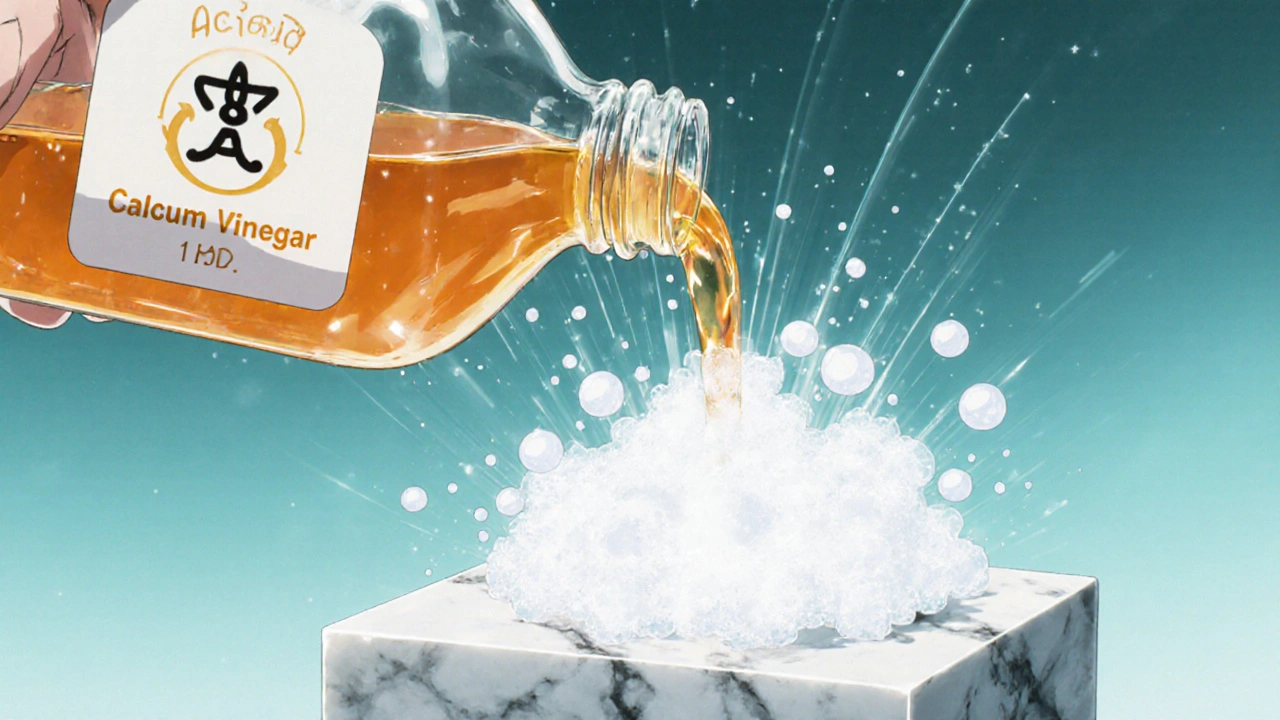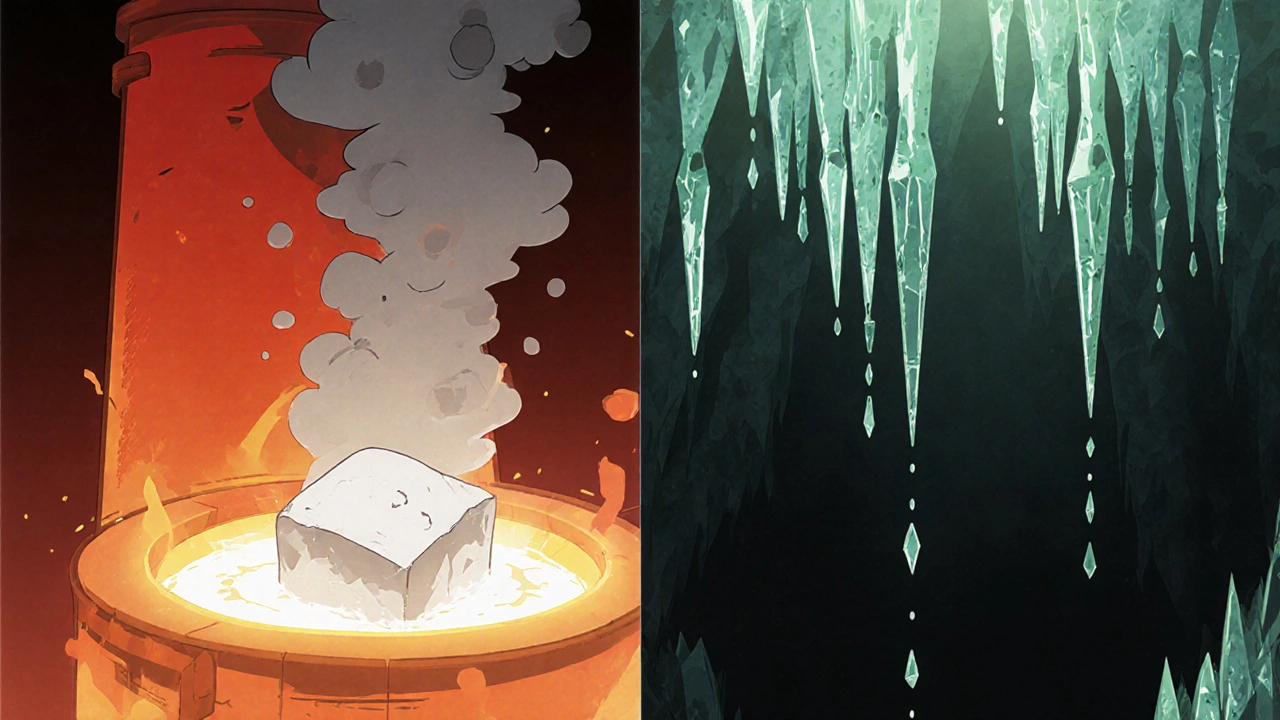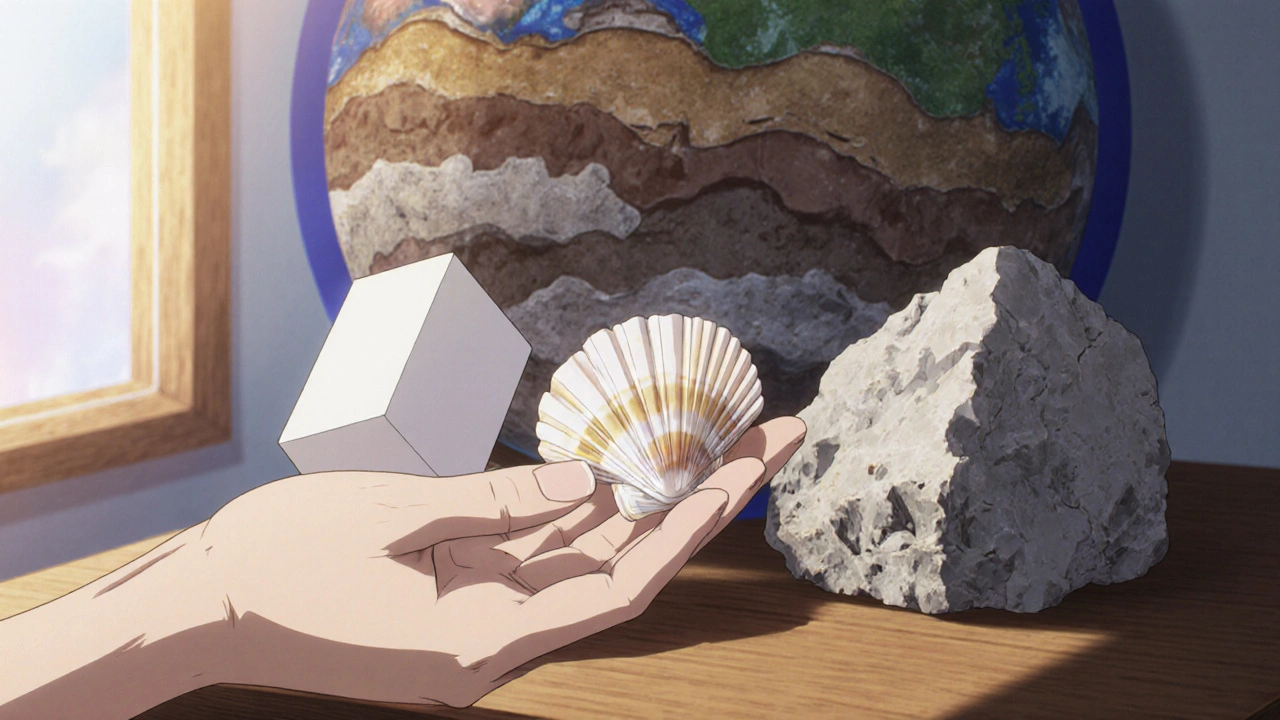Carbonation Reaction Calculator
Calculate the amount of calcium carbonate formed when carbon dioxide reacts with calcium ions in water. This demonstrates the natural carbonation process described in the article, including how CO2 sequestration occurs in limestone formation and cave development.
Reaction Results
Reaction equation from article section: Carbonation: building stones in nature
When you pick up a piece of chalk, a seashell, or a chunk of limestone, you’re actually holding a mineral that has been at work in the Earth for millions of years. Calcium carbonate is a white, sparingly soluble solid with the formula CaCO3. Its simple makeup hides a surprisingly rich chemistry that shows up in everything from your morning coffee to giant limestone cliffs.
In the next few minutes you’ll see why calcium carbonate is more than just a boring white powder. We’ll walk through its most common reactions, the conditions that drive them, and the everyday uses that stem from each pathway.
Acid‑base reaction: why vinegar eats chalk
One of the first experiments many of us try in school is dropping vinegar on a marble slab and watching it fizz. The fizz is the release of carbon dioxide gas, and the chemistry behind it is a classic acid‑base reaction.
Hydrochloric acid (HCl) is a strong mineral acid that donates protons (H+) to carbonate ions (CO32‑) in calcium carbonate.
The balanced equation reads:
CaCO3 + 2 HCl → CaCl2 + CO2↑ + H2O
Two things happen at once: calcium ions pair with chloride to form soluble calcium chloride, and carbon dioxide bubbles out of solution. This reaction is why antacids that contain calcium carbonate can neutralize excess stomach acid, and why acid cleaners can dissolve lime scale on pipes.
Thermal decomposition: heating chalk into lime
When you turn up the heat on calcium carbonate, a totally different story unfolds. At around 825°C (1,517°F), the mineral breaks down in a process called calcination.
Thermal decomposition of calcium carbonate produces quicklime (calcium oxide) and carbon dioxide:
CaCO3 → CaO + CO2
Quicklime is a highly reactive base used to make cement, treat soils, and even desulfurize steel. The CO₂ released in the kiln can be captured and reused, turning a waste stream into a feedstock for carbonation processes.
Carbonation: building stones in nature
Carbon dioxide isn’t just a greenhouse gas; it’s also a key player in forming more calcium carbonate in the environment.
Carbon dioxide dissolves in water to make carbonic acid (H₂CO₃), which then reacts with calcium ions:
Ca2+ + H₂CO₃ → CaCO3 + H+
This reaction is the engine behind the growth of stalactites and stalagmites in caves, the formation of limestone reefs, and the hardening of concrete over time. In karst landscapes, the process works in reverse when slightly acidic rainwater slowly dissolves existing calcium carbonate, carving out sinkholes and underground rivers.

Polymorphs: calcite vs. aragonite
Not all calcium carbonate crystals look the same. Two major polymorphs-calcite and aragonite-share the same chemical formula but differ in crystal structure.
Calcite forms rhombohedral crystals and is the most stable form at Earth’s surface conditions. It makes up the bulk of sedimentary limestone and marble.
Aragonite crystallizes in an orthorhombic lattice, is denser, and tends to form in marine settings, such as the shells of mollusks and the skeletons of corals. Over geological time, aragonite can recrystallize into calcite, a process that records past ocean chemistry in the rock record.
Solubility and buffering in water
Calcium carbonate’s low solubility makes it a natural pH buffer in freshwater and seawater. When a small amount dissolves, it creates a balance between calcium ions, carbonate ions, and bicarbonate ions:
CaCO3 + H₂O ⇌ Ca2+ + HCO₃- + OH-
This equilibrium helps keep the pH of natural waters near neutral, protecting aquatic life. In aquaculture, adding finely ground calcium carbonate can stabilize water chemistry and provide a calcium source for shell‑forming organisms.
Industrial and environmental applications
Because it reacts predictably under acid, heat, and CO₂ conditions, calcium carbonate is a workhorse in many sectors:
- Construction: Ground limestone is a key filler in concrete, drywall, and paint, improving strength and fire resistance.
- Paper & plastics: It acts as a brightening agent and filler that reduces material costs.
- Environmental remediation: Adding calcium carbonate to acidic soils or mine runoff neutralizes pH and immobilizes heavy metals.
- Carbon capture: Post‑combustion CO₂ streams can be mineralized by reacting with calcium carbonate to form stable calcium carbonate aggregates.
Each use hinges on one of the reactions described above, whether it’s a simple acid neutralization or a high‑temperature calcination step.

Safety, handling, and common misconceptions
Although calcium carbonate is non‑toxic, inhaling fine dust can irritate the lungs, so wearing a mask in industrial settings is wise. It’s also a myth that “all limestone is the same”; the mineral’s purity, grain size, and polymorph affect performance in specific applications.
Quick reference: how the main reactions compare
| Reaction Type | Reactants | Typical Conditions | Primary Products | Common Uses |
|---|---|---|---|---|
| Acid-base neutralization | CaCO3 + 2H⁺ (e.g., HCl) | Room temperature, aqueous | Ca²⁺, CO2↑, H₂O | Antacids, lime‑scale removal |
| Thermal decomposition (calcination) | CaCO3 | ≈825°C, dry kiln | CaO (quicklime), CO2↑ | Cement, steel desulfurization |
| Carbonation (natural formation) | Ca²⁺ + CO₂ + H₂O | Ambient pressure, slightly acidic water | CaCO3 precipitate | Cave formation, reef building, CO₂ sequestration |
Frequently Asked Questions
What makes calcium carbonate dissolve in acid?
Acids donate protons that combine with the carbonate ion to form carbonic acid, which quickly breaks down into water and carbon dioxide gas. The gas bubbles away, pulling the reaction forward.
Why is quicklime so reactive compared to calcium carbonate?
Quicklime (CaO) lacks the stabilizing carbonate group. When it contacts water, it rehydrates to calcium hydroxide and releases a lot of heat, making it useful for soil amendment and cement production.
Can calcium carbonate be used to capture carbon dioxide?
Yes. In engineered mineralization, captured CO₂ is reacted with calcium-rich waste streams under pressure to precipitate solid CaCO₃, effectively locking the carbon in a stable mineral form.
What’s the difference between calcite and aragonite?
Both are CaCO₃, but calcite crystals are rhombohedral and stable at surface conditions, while aragonite crystals are orthorhombic, denser, and form mostly in marine environments. Over time, aragonite can convert to calcite.
Is limestone the same as calcium carbonate?
Limestone is a rock composed largely of calcium carbonate, but it often contains impurities like clay, quartz, or organic material, which can affect its chemical behavior.





Comments (12)